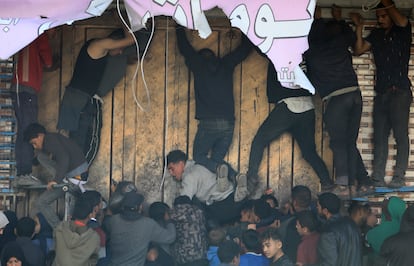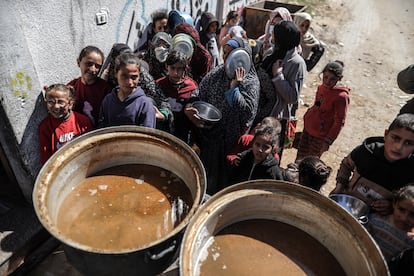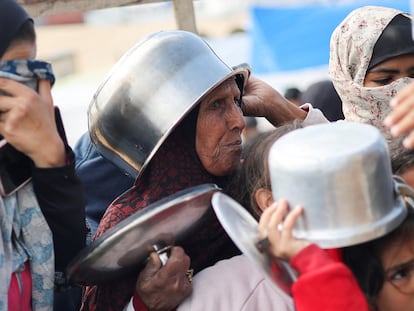Chaos and hunger heighten tragedies in Gaza
Thursday’s attack on an aid delivery, which left over 100 people dead, highlights the malnutrition and collapse of public order caused by the Israeli invasion

A handful of young people pose for the camera with their faces covered. They are all men, some with Kalashnikov rifles and others with wooden batons. On their foreheads they wear a bandanna with the words “Popular Protection Committees,” in the style of the militia, but much more rustic, a reflection of the lack of almost everything that the Palestinian strip is experiencing. One of them announces the birth of the committees to support the Ministry of Interior of the Hamas government in Gaza in providing “security and stability,” and “controlling excessive prices.” They seek to convey authority, but achieve the opposite: there are about 10 of them, all in their twenties (at most), to regulate the situation generated by the Israeli decision to overthrow Hamas — the Islamist party-militia that has ruled the enclave since 2007 and launched the October 7 attacks — and to use humanitarian aid as a weapon of war. In other words, malnutrition — half a million people are on the brink of starvation — assaults on aid trucks and a black market that further divides Gazans between those who had money before the war, and those who did not.
Against this backdrop, with thousands of people struggling to get hold of one of the very scarce shipments of flour entering northern Gaza, the Israeli army opened fire on Thursday. More than 100 people were killed, either by gunfire or crushed by vehicles.
The committees were born this week in the only place where they could have been: Rafah, forcibly home to the majority of Gaza’s population of around 2.3 million. It is where something resembling a government authority remains after nearly five months of war, as it is the only city the Israeli army has not yet overrun. Israeli Prime Minister Benjamin Netanyahu re-emphasized Thursday that the war will not end without his troops launching an assault there. “Let there be no doubt,” despite “mounting international pressure,” he told a press conference in Tel Aviv.
The convoy tragedy took place in Gaza City, the capital of the Strip. It is in the north of the enclave, where 15.6% of babies — compared to virtually none before the war — under the age of two are severely malnourished. Hamas government health officials in Gaza on Thursday put the number of children who have died of malnutrition or dehydration in recent days in hospitals in the area at 10. The Famine Review Committee, made up of international food security and nutrition experts, has detected at least one of three indicators of famine among the 400,000 to 500,000 inhabitants remaining in the north. More than 80% of the world’s people in phase five, the most severe in food crises, are in Gaza: 576,000 people “one step away from famine,” according to the United Nations Office of Humanitarian Affairs (OCHA).

Aid boxes dropped into the sea and Israel
Some countries, such as Jordan, France, and the United Arab Emirates, have begun to airdrop humanitarian aid — with the green light from Israel — but the result is only tiny fraction of the needs of a desperate population. Most of the boxes dropped on Tuesday by Jordanian military aircraft ended up in the sea. On social networks, a crowd of people could be seen on the shore, waiting for the waves to bring them closer, while fishermen tried to reach them. Many of those salvaged were unusable. A new attempt Thursday generated even more frustration: the wind displaced the parachutes as they descended and, because the Strip is so narrow (7.4 miles at its widest point between the Mediterranean and the Israeli border), they fell into Israel.
Aid organizations have taken to the air because land routes have proven complicated and dangerous for weeks. Israeli military aircraft have bombed police escorting convoys, leading officers to refuse to expose themselves by accompanying the deliveries, according to the United Nations agency for Palestinian refugees (UNRWA). Drivers are thus left at the mercy of hungry crowds and gangs who try to loot the goods for resale on the black market. Some street stalls display products that should be free of charge.
Over the last few weeks images of dozens of Palestinians climbing onto aid trucks or running behind them to catch up have been posted on social media, as well as people taking sacks of flour, which never reached their destination, to their homes or tents. Due to a lack of flour, some families in the north are preparing pita bread with the ground feed they used to give to their animals.
Two such incidents led the UN World Food Program last week to announce the cessation of humanitarian aid deliveries to the north: in the first, on February 18, “a crowd of hungry people” made “numerous attempts” to board the convoy on its way to Gaza City. On entering the capital, it was even shot at. In the second, a day later, a driver was assaulted and several trucks with flour were looted before reaching Deir al-Balah, in central Gaza.
In the past three weeks, an average of fewer than 100 trucks per day have entered Gaza from Egypt. That is 100 fewer than Israel’s commitment and 400 less than before the war. Israel blames the bottleneck (there is an endless line of trucks in Egypt waiting to pass through) on the UN’s inefficiency in getting them in and distributing them.
Fifty percent less aid was arriving in February than in January, UNRWA’s top official, Philippe Lazzarini, denounced Tuesday on the social network X. “Aid was supposed to increase not decrease to address the huge needs of two million Palestinians in desperate living conditions.,” he said. “Among the obstacles: lack of political will, regular closing of the crossing points plus lack of security due to military operations and collapse of civil order.” On February 5, moreover, a truck from one of their convoys was attacked on the road by Israeli naval forces, despite the delivery having been previously coordinated with the army. There were no injuries, but a large part of the wheat flour it was carrying was lost and it had to turn back.
Sign up for our weekly newsletter to get more English-language news coverage from EL PAÍS USA Edition
Tu suscripción se está usando en otro dispositivo
¿Quieres añadir otro usuario a tu suscripción?
Si continúas leyendo en este dispositivo, no se podrá leer en el otro.
FlechaTu suscripción se está usando en otro dispositivo y solo puedes acceder a EL PAÍS desde un dispositivo a la vez.
Si quieres compartir tu cuenta, cambia tu suscripción a la modalidad Premium, así podrás añadir otro usuario. Cada uno accederá con su propia cuenta de email, lo que os permitirá personalizar vuestra experiencia en EL PAÍS.
¿Tienes una suscripción de empresa? Accede aquí para contratar más cuentas.
En el caso de no saber quién está usando tu cuenta, te recomendamos cambiar tu contraseña aquí.
Si decides continuar compartiendo tu cuenta, este mensaje se mostrará en tu dispositivo y en el de la otra persona que está usando tu cuenta de forma indefinida, afectando a tu experiencia de lectura. Puedes consultar aquí los términos y condiciones de la suscripción digital.
More information
Archived In
Últimas noticias
Most viewed
- Sinaloa Cartel war is taking its toll on Los Chapitos
- Oona Chaplin: ‘I told James Cameron that I was living in a treehouse and starting a permaculture project with a friend’
- Reinhard Genzel, Nobel laureate in physics: ‘One-minute videos will never give you the truth’
- Why the price of coffee has skyrocketed: from Brazilian plantations to specialty coffee houses
- Silver prices are going crazy: This is what’s fueling the rally











































